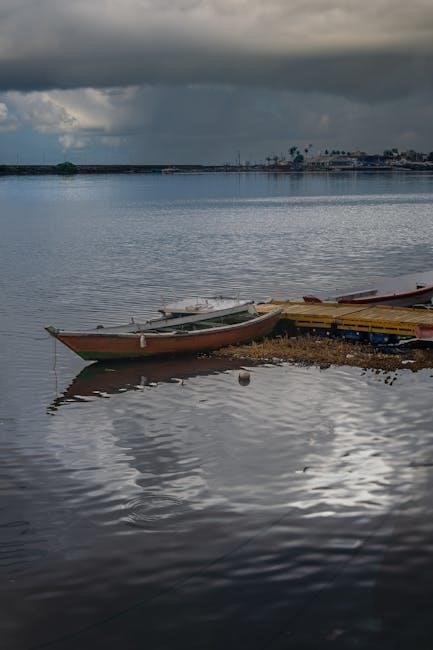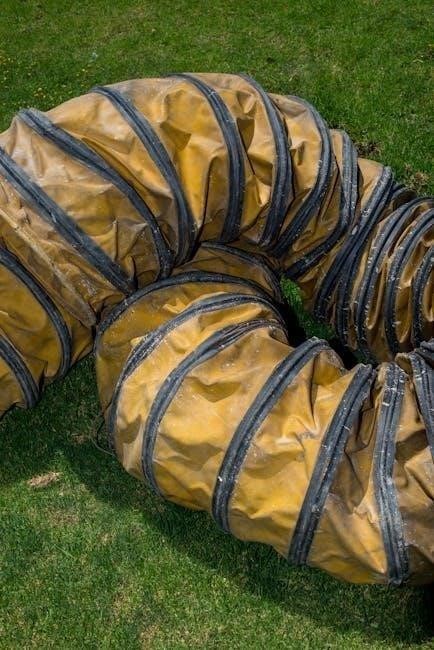The SPCC Regional Inspectors Guide serves as a comprehensive resource for EPA regional inspectors‚ facility owners/operators‚ and the public. It provides detailed guidance on implementing SPCC rule requirements‚ ensuring compliance through clear procedures and standards.
1.1 Purpose and Scope of the Guidance
The SPCC Regional Inspectors Guide is designed to assist EPA regional inspectors in effectively implementing and enforcing the Spill Prevention‚ Control‚ and Countermeasure (SPCC) rule. Its purpose is to provide clear guidance on reviewing facility compliance‚ understanding applicability‚ and evaluating performance-based requirements. The scope includes environmental equivalence‚ impracticability determinations‚ and integrity testing‚ ensuring inspectors have the tools to assess compliance accurately. This document also serves as a resource for facility owners/operators to understand their responsibilities under the SPCC rule.
1.2 Overview of the SPCC Rule and Its Importance
The SPCC rule‚ codified at 40 CFR Part 112‚ aims to prevent oil spills and ensure effective response measures. It requires facilities to develop and implement Spill Prevention‚ Control‚ and Countermeasure Plans. The rule is crucial for protecting waterways‚ reducing environmental risks‚ and ensuring compliance with federal regulations. By establishing clear standards‚ the SPCC rule promotes environmental stewardship and accountability among facility owners/operators‚ safeguarding ecosystems from potential oil spills and fostering a proactive approach to pollution prevention.

Key Provisions of the SPCC Rule
The SPCC rule outlines requirements for spill prevention‚ control‚ and countermeasure plans‚ focusing on environmental equivalence‚ integrity testing‚ and secondary containment to prevent oil spills and ensure compliance.
2.1 Environmental Equivalence and Impracticability Determinations
Environmental equivalence and impracticability determinations are key provisions under the SPCC rule‚ enabling facilities to use alternative measures when traditional secondary containment is not feasible. These determinations ensure that alternative methods provide equivalent environmental protection. The guidance outlines criteria for assessing impracticability‚ such as technical or financial challenges‚ and explains how to document these determinations. Regional inspectors review these assessments to ensure compliance and environmental safety. Proper documentation and approval processes are emphasized to maintain regulatory standards effectively.
2.2 Integrity Testing Requirements for SPCC Plans
Integrity testing is a critical component of SPCC plans‚ ensuring the reliability of containment systems. The SPCC rule mandates regular testing to identify potential leaks or weaknesses in storage tanks and associated equipment. Facilities must conduct these tests in accordance with industry standards and EPA guidelines. The guidance provides inspectors with criteria to evaluate testing methods‚ ensuring compliance and environmental protection. Proper documentation of test results is essential for maintaining regulatory adherence and preventing oil spills. These requirements help safeguard against environmental hazards through proactive system evaluation.

Structure of the SPCC Guidance Document
The SPCC Guidance Document is organized into seven main chapters‚ appendices‚ a glossary of terms‚ and an index‚ providing a comprehensive framework for understanding the SPCC rule.
3.1 Main Chapters and Appendices
The SPCC Guidance Document is structured into seven main chapters‚ each addressing specific aspects of the SPCC rule. Appendices provide additional resources‚ including inspection checklists‚ templates‚ and technical guidance. The document also includes a glossary of terms and an index for easy navigation. These sections collectively ensure that regional inspectors‚ facility owners‚ and operators have a clear understanding of the rule’s requirements and implementation processes. The appendices further support compliance by offering practical tools and references.
3.2 Glossary of Terms and Index
The glossary of terms provides clear definitions of key concepts within the SPCC rule‚ ensuring a common understanding for inspectors‚ facility owners‚ and operators. The index offers a detailed listing of topics‚ enabling quick access to specific sections of the guidance document. Together‚ these resources enhance the usability of the guide‚ making it easier to navigate and apply the regulations effectively. They are essential tools for interpreting and implementing the SPCC rule accurately.

Role of EPA Regional Inspectors
EPA regional inspectors play a critical role in ensuring compliance with the SPCC rule by conducting on-site evaluations‚ reviewing facility plans‚ and providing guidance to facility owners/operators.
4.1 Responsibilities in Implementing the SPCC Rule
EPA regional inspectors are responsible for ensuring facilities comply with the SPCC rule through on-site evaluations and reviews of SPCC plans. They verify the implementation of spill prevention measures‚ secondary containment systems‚ and integrity testing protocols. Inspectors also assess environmental equivalence and impracticability determinations‚ providing guidance to facility owners/operators. Their role is critical in enforcing regulatory standards‚ preventing oil spills‚ and protecting environmental resources. Regular inspections and detailed reporting are essential components of their responsibilities to ensure adherence to the SPCC rule effectively.
4.2 Training and Resources for Inspectors
EPA provides training programs and resources to equip regional inspectors with the knowledge and tools needed to effectively implement the SPCC rule. These resources include updated guidance documents‚ inspection checklists‚ and technical manuals. Inspectors also receive training on regulatory updates‚ environmental equivalence determinations‚ and secondary containment requirements. Additionally‚ the EPA offers workshops and webinars to ensure inspectors are well-versed in the latest compliance strategies and inspection techniques. These resources enable inspectors to perform their duties efficiently and ensure consistent enforcement of the SPCC rule nationwide.

Secondary Containment Requirements
Secondary containment systems are structures designed to hold spills‚ ensuring environmental protection. These requirements are crucial for compliance with the SPCC rule and preventing oil releases.
5.1 Types of Secondary Containment Systems
Secondary containment systems vary‚ including double-walled tanks‚ berms‚ dikes‚ and spill pans. These structures prevent oil spills from reaching the environment. Concrete pads‚ liners‚ and vaults are also used. Each system must meet SPCC requirements‚ ensuring integrity and capacity to hold potential spills. Regular inspections are necessary to maintain effectiveness. The choice of system depends on site specifics‚ cost‚ and maintenance needs. These measures help protect waterways and soil‚ aligning with environmental regulations and safety standards.
5.2 Impracticability Determinations for Secondary Containment
Impracticability determinations allow facilities to seek exemptions from secondary containment requirements due to technical or financial challenges. These determinations must be thoroughly documented and approved by the EPA. Factors like site conditions‚ costs‚ and environmental benefits are considered. If granted‚ alternative measures must be implemented to ensure spill prevention and control. Inspectors verify compliance with these determinations during facility reviews. The process ensures environmental protection while addressing practical limitations for facility operators. Proper documentation and approval are critical for maintaining regulatory compliance and avoiding penalties.

Inspection Checklists and Procedures
Annual and monthly inspection checklists ensure compliance with SPCC requirements. These procedures focus on equipment integrity‚ spill prevention measures‚ and documentation. Completed checklists must be retained for 36 months.
6.1 Annual Inspection Requirements
Annual inspections are conducted to ensure compliance with the SPCC rule. Regional inspectors review spill prevention measures‚ secondary containment systems‚ and documentation. Facilities must maintain records of inspections‚ including checklists and corrective actions. Annual inspections focus on equipment integrity‚ operational compliance‚ and adherence to the SPCC plan. Inspectors verify that all requirements are met‚ and any deficiencies are addressed promptly. These inspections are critical for preventing oil spills and ensuring environmental protection. Completed checklists must be retained for at least 36 months.
6.2 Monthly Inspection Checklists for Facilities
Monthly inspections are essential for maintaining compliance with SPCC requirements. Facilities must conduct routine checks of oil storage containers‚ spill prevention equipment‚ and secondary containment systems. Inspection checklists are used to document findings‚ ensuring all components function properly. Any issues identified must be corrected promptly to prevent potential spills. Records of monthly inspections should be maintained for a minimum of 36 months. These checklists serve as a proactive measure to ensure ongoing compliance and environmental protection‚ complementing annual inspections conducted by EPA regional inspectors.

Purpose and Scope of the Guidance Document
This document provides clarity on implementing the SPCC rule‚ assisting regional inspectors in understanding its requirements and ensuring facilities comply with environmental regulations effectively and consistently.
7.1 Intent Behind the Guidance for Regional Inspectors
The intent of the SPCC Regional Inspectors Guide is to provide inspectors with a clear framework to review and enforce the SPCC rule effectively. It offers detailed insights into compliance requirements‚ ensuring that facilities implement spill prevention measures properly. The guide also aims to clarify the inspector’s role in evaluating environmental equivalence and impracticability determinations‚ promoting consistent national implementation of the rule. Additionally‚ it serves as a resource for facility owners to understand and meet regulatory expectations‚ fostering environmental protection through proactive measures.
7.2 Applicability and Updates to the SPCC Rule
The SPCC rule applies to facilities with oil storage capacities exceeding specific thresholds‚ ensuring environmental protection through spill prevention measures. Updates to the rule‚ including the 2013 revisions‚ clarify requirements for environmental equivalence‚ secondary containment‚ and integrity testing. These updates aim to enhance compliance while addressing practical challenges faced by facilities. The guidance ensures inspectors and facility owners stay informed about regulatory changes‚ promoting consistent implementation and adaptation to emerging environmental protection strategies.

Facility Compliance and SPCC Plans
Facility compliance with SPCC requirements ensures effective spill prevention and preparedness. SPCC plans must be regularly reviewed and updated to maintain regulatory adherence and environmental safety standards.
8.1 Requirements for SPCC Plan Implementation
The SPCC Plan must include specific requirements to ensure environmental protection. Key elements include environmental equivalence‚ secondary containment‚ and integrity testing; Facilities must conduct regular inspections‚ maintain detailed records‚ and update plans to reflect operational changes. The plan should be tailored to the facility’s unique needs‚ ensuring compliance with 40 CFR Part 112. Proper implementation is crucial for preventing oil spills and protecting the environment.
8;2 Review and Update Process for SPCC Plans
Regular review and updates of SPCC Plans are essential to maintain compliance with the SPCC rule. Facilities must review their plans at least once every five years‚ with updates reflecting operational changes or regulatory amendments. Inspectors verify that plans are current and compliant‚ ensuring all requirements are met. The review process involves assessing environmental equivalence‚ secondary containment‚ and integrity testing. Updates must be documented and approved by a Professional Engineer if applicable. This ensures the plan remains effective in preventing oil spills and protecting the environment.

Understanding the Regulatory Framework
The SPCC rule at 40 CFR Part 112 sets requirements for spill prevention‚ control‚ and countermeasure plans to prevent oil spills. Inspectors ensure facilities comply with these regulations to protect the environment.
9.1 Overview of the SPCC Rule at 40 CFR Part 112
The SPCC rule at 40 CFR Part 112 requires facilities to implement spill prevention‚ control‚ and countermeasure plans to prevent oil discharges. It applies to facilities with aboveground or underground oil storage exceeding specific thresholds. The rule emphasizes proactive measures to mitigate environmental harm. Key components include spill prevention measures‚ control strategies‚ and countermeasures. Facilities must also maintain secondary containment and conduct regular integrity testing. The rule ensures compliance through detailed plans and inspections‚ safeguarding waterways and ecosystems from oil contamination.
9.2 Role of the Inspector in Ensuring Compliance
EPA regional inspectors play a critical role in ensuring facilities comply with the SPCC rule. They conduct on-site evaluations to review SPCC plans‚ verify implementation of spill prevention measures‚ and assess secondary containment systems. Inspectors also check records of integrity testing and corrective actions. Their role includes identifying deficiencies‚ providing guidance for compliance‚ and ensuring facilities address potential oil discharge risks. Regular inspections help maintain environmental protection by enforcing adherence to the SPCC rule and promoting a culture of compliance among facility operators.



0 Comments